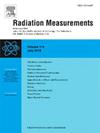使用大小特异性剂量估计值(SSDE)估计器官剂量及其与直接测量的比较
IF 2.2
3区 物理与天体物理
Q2 NUCLEAR SCIENCE & TECHNOLOGY
引用次数: 0
摘要
本研究的目的是在拟人模型中使用尺寸特异性剂量估计值(SSDE)来估计器官剂量,并将结果与使用铅笔电离室和射电光致发光剂量计(RPLDs)的直接测量结果进行比较。方法采用SSDE概念对CT检查中的器官剂量进行估计。由加权SSDE (SSDEw)计算中心SSDE (SSDEc)和外周SSDE (SSDEp)。用插值法从SSDEc和SSDEp建立剂量图。器官剂量或特定位置的剂量计算为确定感兴趣区域(ROI)内剂量图的平均值。我们在东芝Alexion™Access 4层CT扫描仪扫描的拟人幻影上实现了该算法,该扫描仪具有固定管电流(FTC)和管电流调制(TCM)模式。使用铅笔电离室和rpld直接测量拟人化幻影中的器官剂量。采用Kruskal-Wallis检验评估不同方法间是否存在显著性差异。结果使用SSDE估算的器官剂量与使用铅笔电离室和RPLDs直接测量的器官剂量相当。与使用电离室和rpld直接测量相比,在FTC模式下使用SSDE进行的器官剂量估计分别显示出约4.02±0.04%和4.59±0.03%的差异。与使用电离室和rpld直接测量相比,TCM模式的差异分别为5.09±0.03%和17.91±0.08%。统计分析的p值为>;0.05,证实了SSDE方法估计器官剂量的可靠性。结论用SSDE方法估算器官剂量是可行的。使用SSDE的器官剂量与直接测量的剂量相当。本文章由计算机程序翻译,如有差异,请以英文原文为准。
Estimated organ dose using the size-specific dose estimates (SSDE) and its comparison with direct measurements
Purpose
The aim of this study is to estimate the organ dose using the size-specific dose estimates (SSDE) in an anthropomorphic phantom and compare the results with direct measurements using a pencil ionization chamber and radio-photo-luminescence dosimeters (RPLDs).
Methods
Organ dose estimation in computed tomography (CT) examination was performed using the SSDE concept. The central SSDE (SSDEc) and peripheral SSDE (SSDEp) were calculated from the weighted SSDE (SSDEw). A dose map was created from SSDEc and SSDEp with interpolation. Organ dose or dose at a specific position was calculated as the average of the dose map within a defined region of interest (ROI). We implemented the algorithm on an anthropomorphic phantom scanned by a Toshiba Alexion™ Access 4-slice CT scanner with both fixed tube current (FTC) and tube current modulation (TCM) modes. A pencil ionization chamber and RPLDs were used to measure the organ dose directly in the anthropomorphic phantom. The Kruskal-Wallis test was performed to assess whether there was any significance difference among the methods.
Results
The organ doses estimated using SSDE were comparable with the direct measurements using a pencil ionization chamber and RPLDs. The organ dose estimation using SSDE in FTC mode exhibits a discrepancy of approximately 4.02 ± 0.04 % and 4.59 ± 0.03 % compared to the direct measurements using the ionization chamber and RPLDs, respectively. The differences in the TCM mode are 5.09 ± 0.03 % and 17.91 ± 0.08 % compared to the direct measurements using an ionization chamber and RPLDs, respectively. The statistical analysis yielded a p-value >0.05, confirming the reliability of the SSDE method for organ dose estimation.
Conclusion
Organ dose estimation using the SSDE method has been successfully validated. The organ dose using SSDE was comparable to those from direct measurements.
求助全文
通过发布文献求助,成功后即可免费获取论文全文。
去求助
来源期刊

Radiation Measurements
工程技术-核科学技术
CiteScore
4.10
自引率
20.00%
发文量
116
审稿时长
48 days
期刊介绍:
The journal seeks to publish papers that present advances in the following areas: spontaneous and stimulated luminescence (including scintillating materials, thermoluminescence, and optically stimulated luminescence); electron spin resonance of natural and synthetic materials; the physics, design and performance of radiation measurements (including computational modelling such as electronic transport simulations); the novel basic aspects of radiation measurement in medical physics. Studies of energy-transfer phenomena, track physics and microdosimetry are also of interest to the journal.
Applications relevant to the journal, particularly where they present novel detection techniques, novel analytical approaches or novel materials, include: personal dosimetry (including dosimetric quantities, active/electronic and passive monitoring techniques for photon, neutron and charged-particle exposures); environmental dosimetry (including methodological advances and predictive models related to radon, but generally excluding local survey results of radon where the main aim is to establish the radiation risk to populations); cosmic and high-energy radiation measurements (including dosimetry, space radiation effects, and single event upsets); dosimetry-based archaeological and Quaternary dating; dosimetry-based approaches to thermochronometry; accident and retrospective dosimetry (including activation detectors), and dosimetry and measurements related to medical applications.
 求助内容:
求助内容: 应助结果提醒方式:
应助结果提醒方式:


